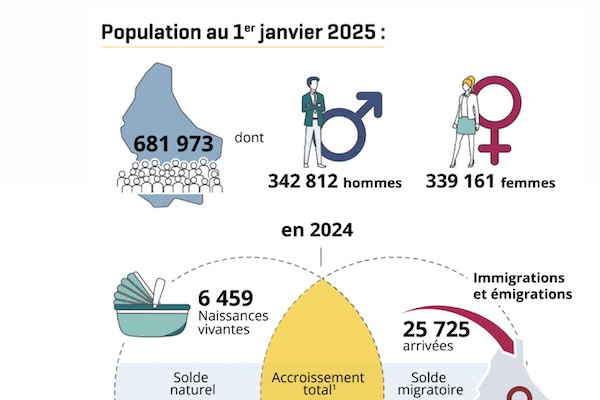 Credit: STATEC
Credit: STATEC
Luxembourg’s national statistics institute, STATEC, has published the country’s demographic figures for 2025; as of 1 January 2025, Luxembourg had a population of 681,973 an increase of 1.5% or 9,923 compared to 2024.
STATEC reported that the population increase is one of the lowest of the last decade (where it varied between 2.0 and 2.5%), with the exception of the COVID-19 pandemic years (1.4 and 1.7% in 2020 and 2021, (respectively).
Age profile
As of 1 January 2025, the average age of the population was 40.7 years for women and 39.3 years for men.
Foreign residents were significantly younger than Luxembourgers. The average age for Luxembourg women was 42.2 years, compared to 38.9 years for foreign women. For Luxembourg men, the average age was 40.0 years, compared to 38.6 years for foreign men.
Continuously declining fertility
The number of births observed in 2024 was slightly higher than that of 2023: 6,459 births in 2024 compared to 6,320 births in 2023 (+2.2%). Despite this slight increase in the number of births, the total fertility rate remained low, standing at 1.25 children per woman in 2024 (as in 2023). Since the early 2000s, Luxembourg has seen a decline in its fertility rate.
The fertility rate of Luxembourgish women was particularly low and is approaching the threshold of one child per woman (1.12 children per woman in 2024). This rate is also decreasing for foreign women, although their fertility rate is higher (1.41 children per woman) than that of Luxembourgish women.
This decline is also observed in other European countries. For example, within the EU-27, the total fertility rate fell from 1.43 children per woman to 1.38 children per woman between 2001 and 2023.
Life expectancy
In 2024, there were 4,471 deaths recorded in Luxembourg, a slight increase from 2023 figures (4,431 deaths), despite a population increase of 1.5%. The natural balance (births minus deaths) was 1,988 people.
Slightly more male deaths (51.5%) than female deaths (48.5%) were reported. 75.0% of deaths were of Luxembourg nationals, compared to 25.0% for deaths of foreign nationals (1,120 deaths). This difference is largely explained by the younger age profile of foreign nationals in the Grand Duchy. The mortality rate, which had increased during the COVID-19 period (7.3 deaths per 1000 inhabitants in 2020 and 7.0 deaths per 1,000 inhabitants in 2021), continued to decline and reached 6.6 per 1,000 in 2024 (compared to 6.7 in 2023). The average age of those deceased was 78.0 years: 81.2 years for women and 75.0 years for men. Following the lower mortality observed in 2024, life expectancy at birth increased to 85.3 years for women and 81.2 years for men. The gap between women and men is narrowing, falling from 7.2 years in 1973 to 4.1 years in 2023.
Immigrations and emigrations
In 2024, Luxembourg recorded 25,725 arrivals (down 4.6% compared to 2023) and 16,444 international departures (down 0.9%). Net migration, i.e. the difference between immigrants and emigrants, was 9,281. In 2024, the highest number of newcomers to Luxembourg were from Portugal (3,469), ahead of France (3,084) and Italy (1,818).
Among emigrants, i.e. people leaving Luxembourg for another country, the top three nationalities were: Luxembourgers (3,346), Portuguese (2,847) and French (2,230).
Foreign population in Luxembourg
As of 1 January 2025, 320,726 foreigners (i.e. those who do not have Luxembourgish nationality) were living in the Grand Duchy, 12.1% of whom were born in Luxembourg. Since Luxembourg's demographic growth is driven by migration, the share of foreigners in the population is therefore significant (47.0%) but is decreasing compared to 2023 (47.3%). This slight decrease results from lower immigration and the acquisition of Luxembourg nationality, which remains high among the resident population.
As of 1 January 2025, 180 nationalities were present in Luxembourg. Among the ten countries with the most nationals, eight are from the EU. The largest non-EU community in this top ten was Ukraine with a total of 5,597 people. The second largest non-European community was the Indian community, with 5,474 nationals.
The Portuguese were the country's largest foreign community (13.1%), followed by the French (7.2%) and the Italians (3.7%). These three foreign communities constituted just over half (51.2%) of the foreign population in 2024. This is followed by the Belgians (2.7%) and the Germans (1.8%).
There were 244,291 foreign nationals with EU nationality. They constituted 76.2% of the foreign resident population. There were 23,836 nationals (7.4%) of non-EU European countries in Luxembourg, 23,164 (7.2%) from Asian countries, 19,455 people (6.1%) from Africa, 9,411 from Caribbean countries, North, South or Central America and 276 people from Oceania countries. Moreover, 293 stateless people or those of unknown nationality resided in the Grand Duchy in 2024.
24.7% of Luxembourgers (compared to 22.7% on 1 January 2024) held a second nationality. Among them, 25.0% had Portuguese nationality, 14.1% had French nationality and 7.2% had Italian nationality.
Acquisition of Luxembourgish nationality
During 2024, a total of 7,415 people (residents and non-residents) obtained Luxembourgish nationality, a decrease of 11,904 (37.7%) compared to 2023. This decrease is due to the lower naturalisation rate of non-residents and can be explained by the fact that it is no longer possible to submit a new application based on a "direct paternal or maternal descendant of a Luxembourgish ancestor on 1 January 1900”.
Marriages and divorces
In 2024, 2,567 marriages were celebrated (+1.1% compared to 2023) in Luxembourg. Of these unions, 89 were between two people of the same sex, including 49 between men and 40 between women. The average age at first marriage was 32.4 years for women and 34.3 years for men.
In 2024, the number of divorces established by the courts was 1,197, a decrease of 11.9% compared to the previous year. The average duration of marriages dissolved in 2024 was 12.5 years.








